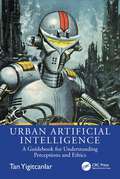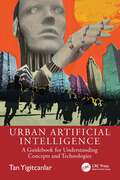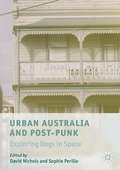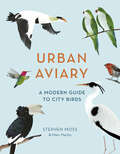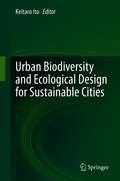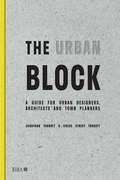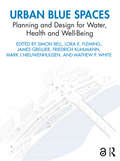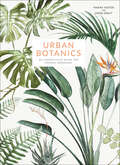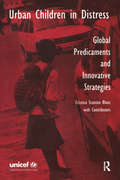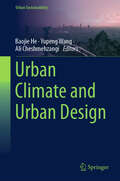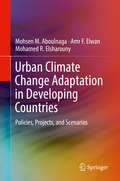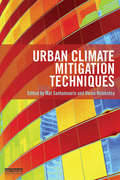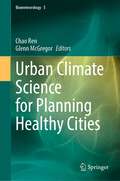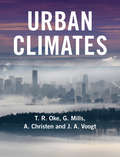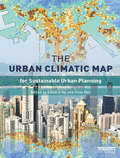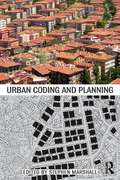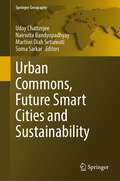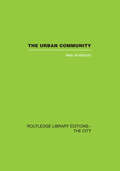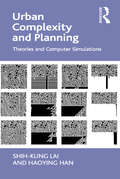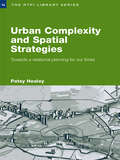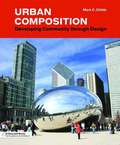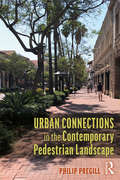- Table View
- List View
Urban Artificial Intelligence: A Guidebook for Understanding Perceptions and Ethics
by Tan YigitcanlarThis volume thoroughly explores the perceptions and ethical considerations surrounding urban artificial intelligence (AI). Tan Yigitcanlar delves into the complex public and professional views on AI, offering invaluable insights for policymakers, urban planners, and developers.As the world rapidly advances technologically, the role of AI has become increasingly significant. AI’s transformative power spans various sectors, revolutionising how we operate and innovate in fields such as healthcare, finance, agriculture, and space exploration. Despite its wide‑reaching impact, the integration of AI into urban planning and development remains relatively underexplored. This is surprising given AI’s immense potential to revolutionise urban design, management, and experience. Comprising eight comprehensive and insightful chapters, this book examines AI’s role in urban contexts, including its applications, public perceptions, and ethical implications. The first part of the guidebook delves into varied perceptions of AI within different urban sectors, presenting detailed perception analyses on AI’s role in urban planning, local government services, disaster management, and the construction industry. The second part shifts focus to the ethical implications and responsible implementation of AI in urban settings. It provides frameworks and strategies to ensure AI technologies contribute positively to urban development while mitigating potential risks and ethical concerns.This volume, alongside its companion Urban Artificial Intelligence: A Guidebook for Understanding Concepts and Technologies, offers a holistic view of Urban Artificial Intelligence. Together, these books provide essential insights for urban planners, policymakers, researchers, and anyone interested in AI and urban development, guiding responsible AI integration to foster smarter, more sustainable, and equitable urban environments.
Urban Artificial Intelligence: A Guidebook for Understanding Concepts and Technologies
by Tan YigitcanlarTan Yigitcanlar offers a comprehensive exploration of artificial intelligence’s (AI) role in shaping modern cities. This volume delves into how AI‑driven analytics and big data provide city planners with deeper insights, enabling more informed decision‑making. These insights lead to more efficient resource use, improved public services, and better infrastructure management.In the digital age, AI is revolutionising various sectors, fundamentally altering our approach to problem‑solving and innovation. AI’s transformative power spans industries from healthcare to finance, and now, it is poised to redefine urban planning and development. Urban areas, as the epicentres of human activity and progress, face myriad challenges such as population growth, resource management, environmental sustainability, and infrastructure development. Traditional methods often fall short in addressing these complexities, making the integration of AI an essential frontier. Comprising seven extensive and insightful chapters, this volume bridges the gap between the theoretical potential and practical implementation of AI in urban contexts. It covers foundational concepts of urban AI, examines its applications across different domains, and explores how AI can improve urban life through smarter home technologies and personalised public services.This first volume is complemented by Urban Artificial Intelligence: A Guidebook for Understanding Perceptions and Ethics, which delves into the ethical and perceptual dimensions of AI in urban settings. Together, these volumes provide a holistic view of urban artificial intelligence, offering essential insights for urban planners, policymakers, researchers, and anyone interested in the intersection of AI and urban development.
Urban Australia and Post-Punk: Exploring Dogs in Space
by David Nichols Sophie PerilloRichard Lowenstein’s 1986 masterpiece Dogs in Space was and remains controversial, divisive, compelling and inspirational. Made less than a decade after the events it is based on, using many of the people involved in those events as actors, the film explored Melbourne’s ‘postpunk’ counterculture of share houses, drugs and decadence. Amongst its ensemble cast was Michael Hutchence, one of the biggest music stars of the period, in his acting debut. This book is a collection of essays exploring the place, period and legacy of Dogs in Space, by people who were there or who have been affected by this remarkable film. The writers are musicians, actors and artists and also academics in heritage, history, urban planning, gender studies, geography, performance and music. This is an invaluable resource for anyone passionate about Australian film, society, culture, history, heritage, music and art.
Urban Aviary: A Modern Guide to City Birds
by Stephen Moss Marc MartinA unique guide to the unusual and often surprising birds that soar above our cities around the world. From frigatebirds wheeling over Rio de Janeiro to bowerbirds displaying in the suburbs of Canberra, penguins in Cape Town to pelicans in San Francisco, and huge flocks of starlings roosting around the Colosseum in Rome, the world&’s cities are home to a remarkable array of feathered citizens.Through Stephen Moss&’s expert knowledge and insight, Urban Aviary provides a beautiful guide to some of the most extraordinary species of city birds that have become native, including helpful spotting hints and fact boxes for each bird, all of which are brought to life by Marc Martin&’s distinctive and beautiful watercolours.
Urban Bikeway Design Guide
by National Association of City Transportation OfficialsThe NACTO Urban Bikeway Design Guide, Second Edition, is based on the experience of the best cycling cities in the world. Completely re-designed with an accessible, four-color layout, this second edition continues to build upon the fast-changing state of the practice at the local level. The designs in this book were developed by cities for cities, since unique urban streets require innovative solutions. To create the Guide, the authors conducted an extensive worldwide literature search from design guidelines and real-life experience. They worked closely with a panel of urban bikeway planning professionals from NACTO member cities and from numerous other cities worldwide, as well as traffic engineers, planners, and academics with deep experience in urban bikeway applications. The Guide offers substantive guidance for cities seeking to improve bicycle transportation in places where competing demands for the use of the right-of-way present unique challenges. First and foremost, the NACTO Urban Bikeway Design Guide, Second Edition will help practitioners make good decisions about urban bikeway design. The treatments outlined in this updated Guide are based on real-life experience in the world's most bicycle friendly cities and have been selected because of their utility in helping cities meet their goals related to bicycle transportation. Praised by Former Transportation Secretary Ray LaHood as an "extraordinary piece of work," the Guide is an indispensable tool every planner must have for their daily transportation design work.
Urban Biodiversity and Ecological Design for Sustainable Cities
by Keitaro ItoThis book highlights various designs for urban green spaces and their functions. It provides an interesting meeting point between Asian, European and North America specialists (researchers, planners, landscape architects) studying urban biodiversity; urban biodiversity and green space; relations between people and biodiversity. The most important feature of this book is the unique point of view from each contributor towards “the relationship between nature and people in urban areas”, in the context of the ecosystem and biodiversity in urban areas and how to manage them. All chapters explore and consider the relationship between humans and nature in cities, a subject which is taking on increasing importance as new cities are conceptualized and planned. These discussion and examples would be useful for urban ecology researchers, biologists, city planners, government staff working in city planning, architects, landscape architects, and university instructors. This book can also be used as a textbook for undergraduate and postgraduate city planning, architecture or landscape architecture courses.
The Urban Block: A Guide for Urban Designers, Architects and Town Planners
by Jonathan Tarbatt Chloe Street TarbattThe block is no more than the land and building area defined by streets. It is the nature of the interface between the two, which has a critical impact on the quality of the spaces between those buildings. The importance of the block to city life is well rehearsed, and in any case, we seldom find ourselves in the business of making cities from scratch. But we are in the business of making new houses, neighbourhoods and new local centres, and we need lots of them: 250,000 a year to be imprecise. Against the background of a burgeoning housing shortage in the UK, there are varied issues to be reconciled. The Urban Block charts the fall and rise of the perimeter block as the staple of urban form and structure from ancient times. It takes you through the process of understanding, defining, structuring and designing the block. Carefully selected urban and suburban case examples explain “do's and don'ts” of good block layout and will help you to produce better masterplans, while staying in touch with commercial realities.
Urban Blue Spaces: Planning and Design for Water, Health and Well-Being
by Simon Bell Lora E. Fleming Friedrich Kuhlmann Mathew P. White Mark J. Nieuwenhuijsen James GrellierThis book presents an evidence-based approach to landscape planning and design for urban blue spaces that maximises the benefits to human health and well-being while minimising the risks. Based on applied research and evidence from primary and secondary data sources stemming from the EU-funded BlueHealth project, the book presents nature-based solutions to promote sustainable and resilient cities. Numerous cities around the world are located alongside bodies of water in the form of coastlines, lakes, rivers and canals, but the relationship between city inhabitants and these water sources has often been ambivalent. In many cities, water has been polluted, engineered or ignored completely. But, due to an increasing awareness of the strong connections between city, people, nature and water and health, this paradigm is shifting. The international editorial team, consisting of researchers and professionals across several disciplines, leads the reader through theoretical aspects, evidence, illustrated case studies, risk assessment and a series of validated tools to aid planning and design before finishing with overarching planning and design principles for a range of blue-space types. Over 200 full-colour illustrations accompany the case-study examples from geographic locations all over the world, including Portugal, the United Kingdom, China, Canada, the US, South Korea, Singapore, Norway and Estonia. With green and blue infrastructure now at the forefront of current policies and trends to promote healthy, sustainable cities, Urban Blue Spaces is a must-have for professionals and students in landscape planning, urban design and environmental design. Open Access for the book was funded by the European Union's Horizon 2020 research and innovation programme under grant agreement No 666773
Urban Botanics: An Indoor Plant Guide for Modern Gardeners
by Maaike Koster Emma SibleyHave trouble keeping house plants alive? Struggling to find your green fingers? Fear not! You can still have a beautiful plant-filled home with this stunning guide to indoor plants. Whether you are looking to cultivate an entire indoor garden, or simply wish to know more about your single cactus, you can be sure to find the right information for you amongst the seventy-five plants in this stylish guide. And the best bit? All the plants are easy to maintain so even the most timid of gardeners can enjoy turning their hand to this green-fingered pastime. Learn how to care for succulents, cacti, flowering and foliage plants even with a full-time job, with this unique gardening guide that is made to fit alongside our modern-day schedules. With endless inspiration to brighten up your home,desk or office, this beautiful book of plants from across the world is a must for lovers of art and design, as well as plants.
Urban Children Distress
by Cristina Szanton BlancThis book describes how deprived urban children and their families and communities try to cope with scarcity, neglect and discrimination. It communicates the smell, the sweat, the agonies and the occasional triumphs of the poor in their day-to-day struggle for a rightful share of human dignity.
Urban China's Rural Fringe: Actors, Dimensions and Management Challenges
by Giulio Verdini Yiwen Wang Xiaonan ZhangGiulio Verdini, PhD in Economics, Urban and Regional Development, from the University of Ferrara, is Associate Professor in Urban Planning and Design and Co-Director of the Research Institute of Urbanisation at Xian Jiaotong-Liverpool University, People's Republic of China. Dr. Yiwen Wang, PhD in Architecture from the University of Nottingham, is Lecturer in Urban Planning and Design at Xian Jiaotong-Liverpool University, People's Republic of China. Dr. Xiaonan Zhang, PhD in Urban Geography at University of Salford, UK, is the former Head of the Department of Urban Planning and Design at Xian Jiaotong- Liverpool University, People's Republic of China.
Urban Climate and Urban Design (Urban Sustainability)
by Baojie He Yupeng Wang Ali CheshmehzangiDue to climate change and urbanization, urban climate change is increasingly prominent with significantly environmental, economic, social, and health consequences. Addressing climate-related risks, threats and disasters in cities to a significant extent means creating resilient, healthy, safe and inclusive built environments. Such an assumption is much truer since cities are the main human settlements of human beings. Typically, urban design is an implementable and tangible pathway to practically deal with the city-climate interactions, while there should be a large transformation from unsustainable urban design patterns towards sustainable ones. Urban Climate and Urban Design is a comprehensive collection of theoretical perspectives and global case study examples focused on three core areas of (i) urban climate monitoring, assessing and forecasting, (ii) mitigation and adaptation strategies, (iii) advanced and emerging design models and tools, and (iv) action plans and policy formulation. This edited volume provides theoretical and methodological references for urban climate research and generates practical implications for mitigation and adaptation capacity improvement. This book will be of interest to a range of researchers from earth and planetary sciences and environmental sciences to engineering, architecture, and urban planning. Beyond them, this book will enlighten policy makers, practitioners, and developers how to properly regulate urban climate through design interventions. We believe this book is promising to narrow the gap in the transition towards climate-resilient cities, and enhance the understanding of new ideas, methods, strategies, and policies.
Urban Climate Change Adaptation in Developing Countries: Policies, Projects, and Scenarios
by Mohsen M. Aboulnaga Amr F. Elwan Mohamed R. ElsharounyThis book describes the risks, impacts, measures, actions and adaptation policies that have developed globally as a result of the severe impacts of global climate change. In-depth chapters focus on climate change assessment (CCA) in terms of vulnerabilities and reflection on the built environment and measures and actions for infrastructure and urban areas. Adaptation actions specific to developing countries such as Egypt are presented and illustrated. Global Climate change adaptation projects (CCAPs) in developing countries, in terms of their targets and performance, are presented and compared with those existing CCAPs in Egypt to draw learned lessons. Climate change scenarios 2080 using simulations are portrayed and discussed with emphasis on a case-study model from existing social housing projects in hot-arid urban areas in Cairo; in an effort to put forward an assessment and evaluation of current CCA techniques. This book helps researchers realize the global impacts of climate change on the built environment and economic sectors, and enhances their understanding of current climate change measures, actions, policies, projects and scenarios.Reviews and illustrates the impact of global climate change risks;Provides an understanding of global climate change risks in seven continents;Illustrates policies and action plans implemented at the global level and developing countries' level;Discusses climate change assessment and vulnerabilities with emphasis on urban areas;Presents measures and action plans to mitigate climate change scenarios by 2080.
Urban Climate Mitigation Techniques
by Mat Santamouris Denia KolokotsaThe urban climate is continuously deteriorating. Urban heat lowers the quality of urban life, increases energy needs, and affects the urban socio-economy. Urban Climate Mitigation Techniques presents steps that can be taken to mitigate this situation through a series of innovative technologies and examples of best practices for the improvement of the urban climate. Including tools for evaluation and a comparative analysis, this book addresses anthropogenic heat, green areas, cool materials and pavements, outdoor shading structures, evaporative cooling and earth cooling. Case studies demonstrate the success and applicability of these measures in various cities throughout the world. Useful for urban designers, architects and planners, Urban Climate Mitigation Techniques is a step by step tour of the innovative technologies improving our urban climate, providing a holistic approach supported by well-established quantitative examples.
Urban Climate Science for Planning Healthy Cities (Biometeorology #5)
by Chao Ren Glenn McGregorThis volume demonstrates how urban climate science can provide valuable information for planning healthy cities. The book illustrates the idea of "Science in Time, Science in Place" by providing worldwide case-based urban climatic planning applications for a variety of regions and countries, utilizing relevant climatic-spatial planning experiences to address local climatic and environmental health issues. Comprised of three major sections entitled "The Rise of Mega-cities and the Concept of Climate Resilience and Healthy Living," "Urban Climate Science in Action," and "Future Challenges and the Way Forward," the book argues for the recognition of climate as a key element of healthy cities. Topics covered include: urban resilience in a climate context, climate responsive planning and urban climate interventions to achieve healthy cities, climate extremes, public health impact, urban climate-related health risk information, urban design and planning, and governance and management of sustainable urban development. The book will appeal to an international audience of practicing planners and designers, public health and built environment professionals, social scientists, researchers in epidemiology, climatology and biometeorology, and international to city scale policy makers.
Urban Climates
by Gerald Mills Andreas Christen James A. Voogt Timothy R. OkeUrban Climates is the first full synthesis of modern scientific and applied research on urban climates. The book begins with an outline of what constitutes an urban ecosystem. It develops a comprehensive terminology for the subject using scale and surface classification as key constructs. It explains the physical principles governing the creation of distinct urban climates, such as airflow around buildings, the heat island, precipitation modification and air pollution, and it then illustrates how this knowledge can be applied to moderate the undesirable consequences of urban development and help create more sustainable and resilient cities. With urban climate science now a fully-fledged field, this timely book fulfills the need to bring together the disparate parts of climate research on cities into a coherent framework. It is an ideal resource for students and researchers in fields such as climatology, urban hydrology, air quality, environmental engineering and urban design.
The Urban Climatic Map: A Methodology for Sustainable Urban Planning
by Edward Ng Chao RenRapid urbanization, higher density and more compact cities have brought about a new science of urban climatology. An understanding of the mapping of this phenomenon is crucial for urban planners. The book brings together experts in the field of Urban Climatic Mapping to provide the state of the art understanding on how urban climatic knowledge can be made available and utilized by urban planners. The book contains the technology, methodology, and various focuses and approaches of urban climatic map making. It illustrates this understanding with examples and case studies from around the world, and it explains how urban climatic information can be analysed, interpreted and applied in urban planning. The book attempts to bridge the gap between the science of urban climatology and the practice of urban planning. It provides a useful one-stop reference for postgraduates, academics and urban climatologists wishing to better understand the needs for urban climatic knowledge in city planning; and urban planners and policy makers interested in applying the knowledge to design future sustainable cities and quality urban spaces.
Urban Coding and Planning: Urban Coding And Planning (Planning, History and Environment Series)
by Stephen MarshallUrban codes have a profound influence on urban form, affecting the design and placement of buildings, streets and public spaces. Historically, their use has helped create some of our best-loved urban environments, while recent advances in coding have been a growing focus of attention, particularly in Britain and North America. However, the full potential for the role of codes has yet to be realized. In Urban Coding and Planning, Stephen Marshall and his contributors investigate the nature and scope of coding; its purposes; the kinds of environments it creates; and, perhaps most importantly, its relationship to urban planning. By bringing together historical and ongoing traditions of coding from around the world – with chapters describing examples from the United Kingdom, France, India, China, Japan, Australia, South Africa, the United States and Latin America – this book provides lessons for today’s theory and practice of place-making.
Urban Commons, Future Smart Cities and Sustainability (Springer Geography)
by Uday Chatterjee Nairwita Bandyopadhyay Martiwi Diah Setiawati Soma SarkarThis book provides a critical theoretical framework for understanding the implementation and development of smart cities as innovation drivers, with long-term effects on productivity, livability, and the sustainability of specific initiatives. This framework is based on an empirical analysis of 21 case studies, which include pioneer projects from various regions. It investigates how successful smart city initiatives foster technological innovation by combining regulatory governance and private agency. The typologies of smart city-making approaches are thoroughly examined. This book presents the holistic approach of smart cities, which start from current issue and challenges, advanced technological development, disaster mitigation, ecological perspective, social issue, and urban governance. The book is organized into five major parts, which reflect interconnection between theories and practice. Part one explains the introduction which reflects the diversity and challenges of the urban commons and its regeneration. Part two covers the current and future situation of urban growth, anglomeration agglomeration, and urban infrastructure. This section includes rethinking urban sprawl: moving towards sustainable cities, drivers of urban growth and infrastructure, urban land use dynamics and urban sprawl and urban infrastructure sustainability and resilience. Part three describes climate crisis, urban health, and waste management. This section includes climate change and health impacts in urban areas, green spaces: an invaluable resource for delivering sustainable urban health, health and wellbeing and quality of life in the changing urban environment, urban climate and pollution—case study, sustainable urban waste management and urban sustainability and global warming and urban heat Island. Part four covers the ecological perspectives, advanced technology, and social impact for i.e., smart building, ecosystem services, society and future smart cities (SSC). This section includes urban ecosystem services, environmental planning, and city management, artificial intelligence and urban hazards and societal impact, and using geospatial application and urban/smart city energy conservation—case study. Part five covers urban governance, smart solutions, and sustainable cities. It includes good governance, especially e-governance and citizen participation, urban governance, space and policy planning to achieve sustainability, smart city planning and management and Internet of things (IoT), advances in smart roads for future smart cities, sustainable city planning, innovation, and management, future strategy for sustainable smart cities and lessons from the pandemic: the future of smart cities.
Urban Complexity and Planning: Theories and Computer Simulations
by Shih-Kung Lai Haoying HanIn recent years, there has been a new understanding of how cities evolve and function, which reflects the emergent paradigm of complexity. The crux of this view is that cities are created by differentiated actors involved in individual, small-scale projects interacting in a complex way in the urban development process. This 'bottom up' approach to urban modeling not only transforms our understanding of cities, but also improves our capabilities of harnessing the urban development process. For example, we used to think that plans control urban development in an aggregate, holistic way, but what actually happens is that plans only affect differentiated actors in seeking their goals through information. In other words, plans and regulations set restrictions or incentives of individual behaviour in the urban development process through imposing rights, information, and prices, and the analysis of the effects of plans and regulations must take into account the complex urban dynamics at a disaggregate level of the urban development process. Computer simulations provide a rigorous, promising analytic tool that serves as a supplement to the traditional, mathematical approach to depicting complex urban dynamics. Based on the emergent paradigm of complexity, the book provides an innovative set of arguments about how we can gain a better understanding of how cities emerge and function through computer simulations, and how plans affect the evolution of complex urban systems in a way distinct from what we used to think they should. Empirical case studies focus on the development of a compact urban hierarchy in Taiwan, China, and the USA, but derive more generalizable principles and relationships among cities, complexity, and planning.
Urban Complexity and Spatial Strategies: Towards a Relational Planning for Our Times (RTPI Library #14)
by Patsy HealeyUrban Complexity and Spatial Strategies develops important new relational and institutionalist approaches to policy analysis and planning, of relevance to all those with an interest in cities and urban areas. Well-illustrated chapters weave together conceptual development, experience and implications for future practice and address the challenge of urban and metropolitan planning and development. Useful for students, social scientists and policy makers, Urban Complexity and Spatial Strategies offers concepts and detailed cases of interest to those involved in policy development and management, as well as providing a foundation of ideas and experiences, an account of the place-focused practices of governance and an approach to the analysis of governance dynamics. For those in the planning field itself, this book re-interprets the role of planning frameworks in linking spatial patterns to social dynamics with twenty-first century relevance.
Urban Composition
by Mark C. ChildsCities and towns are among humanity's greatest achievements, yet no single individual or organization creates them. The buildings, streets, and gardens of even a small town embody substantial investments of money, natural resources, and political capital. Much more than the sum of its parts, a settlement's vitality comes from its collective composition. Sometimes the cities and towns that emerge are glorious places, but too frequently they have only fragments of greatness or are soulless and environmentally unhealthy. Our new Architecture Brief Urban Composition shows architects, planners, artists, and engineers of individual projects how they can best fulfill their public trust to help make meaningful urban places. Each chapter contains a set of design queries followed by a discussion, illustrations, and references for further research. This accessible primer on urban design provides guidelines for designing buildings or plans for large cities or small towns. Urban Composition showcases projects across the United States and internationally, in metropolitan areas such as Chicago, Seattle, and London, and small communities such as Marfa, Texas.
The Urban Condition (Questioning Cities)
by Brendan GleesonThis book will speak to the new human epoch, the Urban Age. A majority of humanity now lives for the first time in cities. The city, the highest invention of the modern age, is now the human heartland. And yet the same process that brought us the city and its wonders, modernisation, has also thrown up challenges and threats, especially climate change, resource depletion, social division and economic insecurity. This book considers how these threats are encountered and countered in the urban age, focusing on the issue of human knowledge and self-awareness, just as Hannah Arendt’s influential The Human Condition did half a century ago. The Human Condition is now The Urban Condition. And it is this condition that will define human prospects in an age of default and risk. Gleeson expertly explores the concept through three main themes. The first is an exploration of what defines the current human condition, especially the expanding cities that are at the heart of an over-consumptive world economic order. The second exposes and reviews the reawakening of forms of knowledge (‘naturalism’) that are likely to worsen not improve our comprehension of the crisis. The new ‘science of urbanism’ in popular new literature exemplifies this dangerous trend. The third and last part of the book considers prospects for a new urban, and therefore human, dispensation, ‘The Good City’. We must first journey in our urban vessels through troubled times. But can we now start to plot the way to new shores, to a safer, more resilient city that provides for human flourishing? The Urban Condition attempts this ideal, conceiving a new urbanism based on the old idea of self-limitation. The Urban Condition is an original, timely book that reconsiders and redeploys Arendt’s famous notion of The Human Condition in an age of cities and risk. It brings together several important strands of human consideration, urbanisation, climate threat, resource depletion, economic default and critical knowledge and weaves them into a new analysis of the times. It also looks to a future that is nearly with us—of changed climate, resource scarcity and economic stress. The book journeys into these troubled times, proposing the idea of Lifeboat Cities as a way of thinking about the human journey to come
Urban Connections in the Contemporary Pedestrian Landscape
by Philip PregillUrban Connections in the Contemporary Pedestrian Landscape explores the significant physical and cultural changes in our urban areas following the implementation of design strategies and increased pedestrian activity. Beginning with a history of the urban grid, the book then discusses experiential factors of pedestrianized urban landscapes in three scales, arterials, collectors and locals, with an emphasis on inductive and deductive design alternatives. It closely examines elements derived from current urban pedestrian experiences including form, scale, surfaces and identity and provides alternative design solutions for the future. Uniquely focusing on a hierarchical discussion of the quality of contemporary landscape design applications within the urban grid, and with illustrated examples throughout the text, this will be useful recommended reading for academics, researchers and postgraduate students on urban landscape and design courses.
